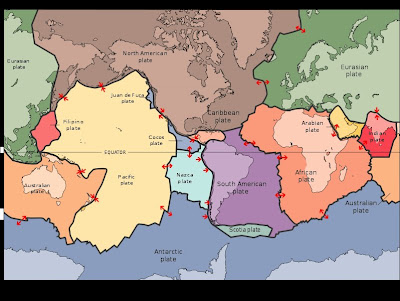The earth has two kinds of crust. The continents are mostly made of thick granite. When continents pull apart, the gap is filled by thin crust made of basalt. In plate tectonics, a continent is any piece of continental crust surrounded by oceanic crust or plate boundaries. Madagascar is a continent. When Africa and eastern Gondwanaland (India, Antarctica and Australia) began to pull apart about 120 million years ago, Madagascar originally moved as part of eastern Gondwanaland. It was originally attached to Kenya, and drifted south until it reached its present location. Then the crust broke on the east side of Madagascar, leaving it attached to the African Plate.
The westerly side is a divergent boundary with the North American Plate to the north and the South American Plate to the south forming the central and southern part of the Mid-Atlantic Ridge. The African plate is bounded on the northeast by the Arabian Plate, the southeast by the Indo-Australian Plate, the north by the Eurasian Plate and the Anatolian Plate, and on the south by the Antarctic Plate. All of these are divergent or spreading boundaries with the exception of the northern boundary with the Eurasian Plate (except for a short segment near the Azores, the Terceira Rift).
Fig-2 Map of East Africa showing some of the historically active volcanoes(red triangles) and the Afar Triangle (shaded, center) -- a triple junction where three plates are pulling away from one another: the Arabian Plate, and the two parts of the African Plate (the Nubian Plate and the Somali Plate) splitting along the East African Rift Zone (USGS).
The African Plate comprises several continental blocks or cartons, stable continental blocks of old rocks, which came together to form the African continent during the assembly of the supercontinent Gondwana around 550 million years ago. These cratons are, from south to north, the Kalahari, Congo, Sahara and West African craton. Each of these cratons can further be subdivided into even smaller blocks or terranes, sutured along pre-Gondwanan orogenic belts.
The African Plate is rifting in the eastern interior along the East African Rift. This rift zone separates the Nubian Plate to the west from the Somali Plate to the east. One hypothesis proposes the existence of a mantle plume beneath the Afar region, while an opposing hypothesis asserts that the rifting is merely a zone of maximum weakness where the African Plate is deforming as plates to its east are moving rapidly northward.
The African Plate's speed is estimated at around 2.15 centimeters per year. It has been moving over the past 100 million years or so in a general northeast direction. This is drawing it closer to the Eurasian Plate, causing subduction where oceanic crust is converging with continental crust (e.g. portions of the central and eastern Mediterranean). In the western Mediterranean, the relative motions of the Eurasian and African plates produce a combination of lateral and compressive forces, concentrated in a zone known as the Azores-Gibraltar Fault Zone. Along its northeast margin, the African Plate is bounded by the Red Sea Rift where the Arabian Plate is moving away from the African Plate.
The New England hotspot in the Atlantic Ocean has probably created a short line of mid to late-Tertiary age seamounts on the African Plate but appears to be currently inactive.


No comments:
Post a Comment